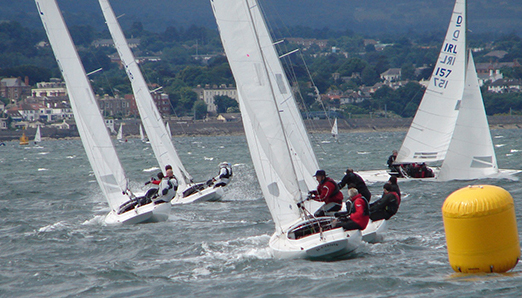Displaying items by tag: National Yacht Club
Local Sailing Class Success Takes Good Boats, But Even Better People
As we near the end of the traditional sailing season, inevitably there’ll be heart-searching among boat owners as to the success and value obtained from their summer afloat – can they really justify the expense of continuing to keep a boat? And with so many imponderables in our sport after a summer which was decidedly mixed in its weather - to say the least - the larger sailing community will be scrutinising those classes which seem to be barely hanging in, those classes which are doing quite well, and those few classes which are spectacularly successful. W M Nixon takes a look at the International Dragons in Glandore, the Flying Fifteens in Dun Laoghaire, and the Puppeteer 22s in Howth to try and find that magic Ingredient X which helps - or has helped - these three very different examples to stay ahead of the game.
The wish to own a boat is a vocation, a calling, a quasi-religious emotional endeavour. It’s all very well for high-flown consultants to tell us that if sailing is going to have general appeal and expand, then publicly-accessed freely-available try-a-sail boats will have to be based at every major club. But dedicated sailors know that what comes easy, goes easy. A spell of bad weather, and your jolly public groups who turned up in droves for a bit of free fun afloat will disappear like the will-o’-the-wisps they were in the first place, seeking instead to find somewhere warm and bright and out of the rain and readily providing the latest novel form of entertainment.
Meanwhile, those who are dyed-in-the-wool boat addicts will have barely noticed the idly-interested strangers coming and going. For whatever the weather, they’ve a boat to maintain, gear to repair, a crew to keep together, and some sensible purpose to find in order to give it all deeper meaning. For they know that unless they’ve a boat and her problems and possibilities occupying a significant part of their mind, they’re going to lose the plot completely.
Nevertheless, in the huge spectrum of boat ownership and sailing classes, why is there so much difference in the successful buzz created by some classes at certain localities, as opposed to the dull and declining murmur emanating from classes which are clearly on the way out?
After all, there are very few utterly awful boats afloat. No boat is completely perfect, though some may seem less imperfect than others. But in today’s throwaway world, if some class of boat is not a reasonably good representative of her general type, then she’ll never make the grade in the first place. And even in times past when news and views moved more slowly, the word soon got around if some much-touted type of boat was in truth a woofer.
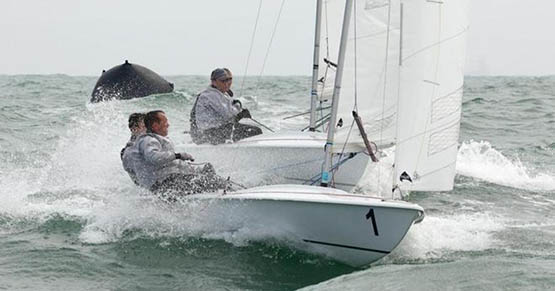
Flying Fifteens provide the best of sport in a very manageable two-man package

The perfect harbour for vintage International Dragons – Glandore, with a goodly selection of classics in port, and Dragons of all ages dotted among them
That said, boat-owning is such an all-consuming passion that once a sailor has finally (or indeed hastily) committed to a particular boat type, then he or she will tend to be absurdly dismissive of any remotely comparable craft. But in the last analysis, the desire to own a boat is irrational. So we shouldn’t be surprised that once the decision is made, irrational attitudes manifest themselves in every direction.
And anyway, as John Maynard Keynes once remarked in a totally different context, in the last analysis we are all dead. So in the meantime, it behoves us to get as much reasonable enjoyment out of life as possible. Thus if owning and sailing a boat is your way of obtaining pleasure without harming anyone else, then good luck to you and me, and let’s look together at boat classes which are doing the business.
In considering the International Dragons in Glandore, the International Flying Fifteens in Dun Laoghaire, and the emphatically not-international Puppeteer 22s in Howth, we are indeed casting the net wide, for really they couldn’t be more different. The 29ft International Dragon originated in the late 1920s from the design board of Johan Anker of Norway, and she has become a by-word for Scandinavian elegance in yacht design, but today she’s totally a racing machine and has strayed far from her original concept as a weekend cruiser for sheltered waters.
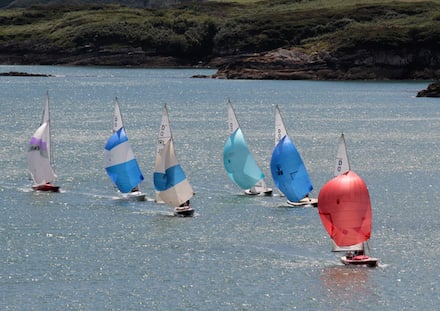
Golden days of classic Dragon racing at Glandore
As for the Flying Fifteen, they originated from designer Uffa Fox having a brainstorm in 1947, in that he took the underwater hull section of the renowned International 14 dinghy in which he was something of a master both as designer and sailor, but above the waterline he drew out the bow to an elegant curved stem, then he lengthened the gentle counter lines to finish in a long sawn-off transom. That done, he added a little hyper-hydrodynamic bulb ballast keel which seemed very trendy, but in truth it’s severely lacking in useful lateral resistance. Nevertheless it gives the boat the reassuring feel of being a small keelboat rather than a big dinghy, and atop it all he put the rig of an International 14 dinghy of that era.
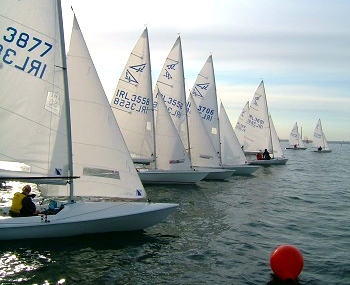
The clean lines of a modern Flying Fifteen fleet. Try to imagine that within each hull there’s an International 14 dinghy, and above it is the original rig
The result was a boat which is really only useful for racing, and it is a design so much of its times that it’s said that many years later the designer himself tried to disown it. But the owners would have nothing to do with this, they liked the compact and very manageable racing-only package which the Flying Fifteen provides, and these days the class has an interesting world spread, and an attractive policy of staging their World Championships at agreeable sunshine destinations where – thanks to their guaranteed ability to turn up with a fleet of viable size – they can arrange block discounts to provide the owners with a very appealing package.
After the sheer internationality of the Dragons and the Flying Fifteens, the Puppeteer 22s are something of a culture shock, as almost every one in existence has ended up based in Howth, where they have such a busy club programme that they only very seldom go south of the Baily, though they do have one annual adventure to Malahide for the Gibney Classic, and once a year they take part in the historic Lambay Race. But otherwise, they’re totally and intensely focused on club racing off Howth.

The Puppeteer 22s seldom stray far from their home port of Howth, for at home they get superbly close racing with a fleet of up to 26 boats in evening racing. This is former ISA President Neil Murphy racing hard at the helm of Yellow Peril, neck and neck with Alan Pearson’s Trick or Treat. Photo: W M Nixon
They were designed by Chris Boyd of Strangford Lough in the mid 1970s to be fractionally-rigged mini-offshore racers, and in all about thirty-three of the Puppeteer 22s were built by C & S Boyd in Killyleagh (Sarah was Chris’s wife). For a while it looked as though they might take off as a semi-offshore One Design class in the north, but somehow they began to trickle down to Howth. They appealed to those sailors who felt that the alternative of a Ruffian 23 with her huge masthead spinnaker was a little too demanding on crews, whereas the Puppeteer’s fractional rig is fairly easily managed. And today the class in Howth is in such good health that even in the poor weather of 2015 they were obtaining regular midweek evening racing best turnouts of up to 26 boats.
Obviously the Puppeteer 22s are now very much a completely localised phenomenom. But while the Flying Fifteens in Dun Laoghaire and the Dragons in Glandore may be representatives of well-established international classes, the fact is in both cases their neighbourhood success is largely due to a distinct local flavour driven by individual enthusiasm. And in Glandore while it’s recognized that the vintage Dragon class was started by Kieran and Don O’Donohue with the classics Pan and Fafner, the man who beats the drum these days for the racing at Glandore as providing “the best and cheapest Dragon racing in the world” is the inimitable Don Street.
Most people will expect that they will be slightly older than the boats they own, and the older you get the greater you’d expect the age gap to be. But Don’s classic Dragon Gypsy is 82 years old. Yet Don himself manages to be that proper little bit senior to her, as he’s 85 and still full of whatever and vinegar, as they’d say in his native New England.
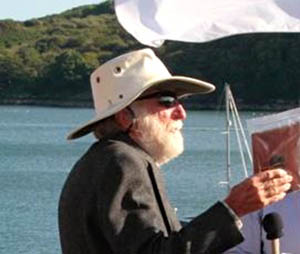
The one and only Don Street in his beloved Glandore. His International Dragon Gypsy is 82 years old, but he still manages to be the senior partner at 85.

Conditions are pleasantly sheltered for the Dragons in Glandore Harbour, but when the fleet goes offshore – as seen here for last year’s championship - they can find all the breeze and lively sea they might want, and more.
The things that Don has done with Gypsy – between intervals of the renowned ocean voyaging with his 1905-built yawl Iolaire which he has now sold – are remarkable, as he sailed Gypsy from Glandore to the classic regatta in Brittany, which is a prodigious offshore passage for an open cockpit racing boat along what the rest of the world would see as significant portions of the most exposed parts of the Fastnet Race course.
Yet although he did such wonderful business with Gypsy on great waters, he has no doubt that the secret of Glandore Dragon racing’s local success is the sheer nearness and convenience of it all. “Down to the pier and out to the boat in five minutes, the starting line is right there, and we don’t race those boring windward-leewards, rather we use club buoys, government navigation marks, islands - and lots of rocks……”
His argument is that with lovely Glandore Harbour being such an fascinating piece of sailing water, part of the interest in keeping up the pace in a local class lies in using those local features, rather than pretending they simply don’t exist by setting courses clear of the land. But of course when the Glandore fleet – which continues as a mix of classic wooden and glassfibre boats – hosts a major event such as last year’s Nationals – which was won by Andrew Craig of Dun Laoghaire in Chimaera – then the courses are set in open water, and they’d some spectacular sailing with it.
In many ways Glandore is a special case, as the population swells in summer with people coming for extended vacations. When that’s the case, their commitment to local Dragon racing can be total, and not least of the occasional local summertime alumni is the great Lawrie Smith. He may have won the Dragon Gold Cup from a fleet of 66 boats last month in Germany under the burgee of another club, but when he’s racing Dragons in Ireland, he’s emphatically under the colours of Glandore Harbour Yacht Club.
Despite these glamorous international links, it’s the folk on the home ground with their dedication to the Dragon Class in Glandore who keep it all going, and it’s Don Street with his dogged determination to prove you can run a Dragon out of pocket money, regardless of the megabucks some might be ready to splash out, which gives the Glandore Dragons that extra something. And in the end it’s all about people, and shared enthusiasm. If you’ve a warm feeling about the Dragon class, and particularly for classic boats in it, then you know that in Glandore you’ll find fellow enthusiasts and every encouragement.
But up in Dun Laoghaire, if you take a look over the granite wall on to the east boat park at the National Yacht Club in summer, and see there the serried ranks of apparently totally identical Flying Fifteens all neatly lined up on their trailers, you could be forgiven for thinking it’s all just ever so slightly clinical, and certainly distinctly impersonal.
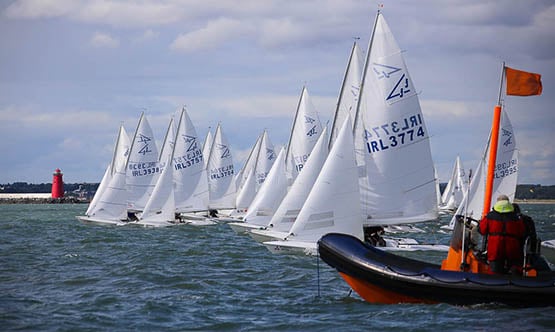
Just about as one design as they could be – the fine fleet at last weekend’s Flying Fifteen Irish Championship in Dublin Bay showed the vigour of the class, which has 47 ranked helmsmen in this country.
Yet you couldn’t be more utterly wrong. Today’s Flying Fifteens may have been technically refined to the ultimate degree to give maximum sport for the minimum of hassle. But their current runaway success – they’re far and away the biggest keelboat One Design class in Dublin Bay – is down to a friendly and very active local class association, and its readiness to reach out the hand of friendship and encouragement to anyone who might be thinking of joining the class’s ranks.
Recently the pace has been set by class captain Ronan Beirne, who recognises that simply announcing and advertising an event is not enough. You have to chivvy people and encourage them into their sailing – particularly after a summer remembered as having had bad weather – and then far from sitting back and smugly counting numbers, you have to keep at it, seeing that crewing gaps are filled, and that those on the fringes are brought to the centre.
The Flying Fifteens – which are essentially a National YC class – offer exceptional value and a very manageable package. The boats are dry-sailed in their road trailers, and instead of queuing for a crane, they have a rapid rota of slip-launching, with the expectation of renewing the wheel bearings each year. Salt water and road trailers are not good partners, but in order to ensure the most efficient launching and retrieval of the boats after each day’s racing, replacing wheel bearings has become something of an art.
The class in Dun Laoghaire secured good sponsorship from Mitsubishi Motors at the beginning of the year, and the sponsors in turn have been rewarded by a thriving class in which inter-personal friendships have developed to such a healthy state that you might find people crewing for someone who would be a complete and untouchable rival at other times in many other classes, but in the Dun Laoghaire Flying Fifteens he’s a fellow enthusiast who happens to be short of a crew on that day.
One of the enthusiastic newcomers to the class this year is Brian O’Neill, who originally hailed from Malahide and was best known for campaigning the family’s Impala 28 Wild Mustard with great success for several years, but now he’s very much a family man living in Dun Laoghaire with three growing kids, and sailing had gone on to the back burner.
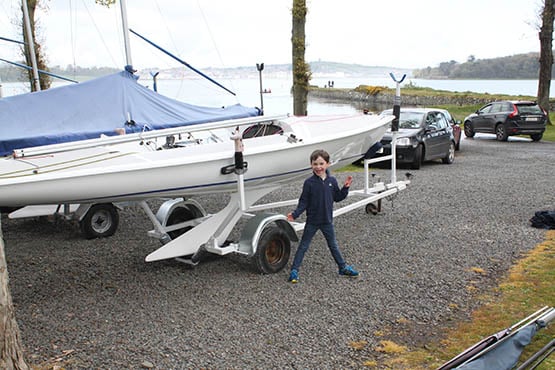
Charlie O’Neill (aged 7) at Strangford SC with dad Brian’s newly acquired Flying Fifteen. Under the rapid moving launching system at the National YC, the dry-sailed Flying Fifteens use their road trailers to get the boats afloat in record time. The need for regular replacement of the wheel bearings is allowed for in each boat’s budget. Photo: Brian O’Neill
But as the National YC is just down the road from where he lives, he was drawn into its welcoming ambience, and soon became aware of the attractive and friendly package offered within the club by the Flying Fifteens. He bought one in good order from an owner at Strangford Sailing Club in the Spring, and was soon in the midst of it. Yet it takes up only a very manageable amount of his time, it simply couldn’t be more convenient, and the people are just great too.
Who knows, but having won the class’s last evening race of the 2015 season, he might even be prepared to travel to maybe one event at another venue in Ireland. But the primary attraction continues to be the class’s strong local ethos and ready racing at the National, the friendliness of fellow Flying Fifteen sailors, and the sheer manageability of the whole thing – this is not a boat where the ownership gets on top of you.
If you want to get the flavour of Dun Laoghaire Flying Fifteen racing, you get a heightened sense of it from the report in Afloat.ie of how David Gorman and Chris Doorly won last weekend’s Irish championship in classic style, and if this isn’t good value in sailing and personal boat ownership, then I don’t know what is.
Across Dublin Bay in those misty waters of Fingal beyond the Baily, your correspondent found himself reporting aboard Alan “Algy” Pearson’s Puppeteer 22 Trick or Treat last Saturday for the opening race of the MSL Park Motors Autumn League. I did so with some trepidation, for Alan has a super young crew recruited from Sutton Dinghy Club in the form of GP14 ace Alan Blay, Ryan Sinnott and Claud Mollard, but our cheerful skipper said that as the day was brisk, they needed the fifth on board for ballast.
In fact, I’d only once raced a Puppeteer before, in the lightest of winds when somehow we managed a win. But as this race progressed with the skipper and his young tacticians making a perfect call for the long beat in a good long course which made full use of the splendid sailing waters north of Howth, by the last leg after many place changes it looked as though another win might be on the cards.

Action stations. Puppeteer 22s closing in for their start. Photo: W M Nixon
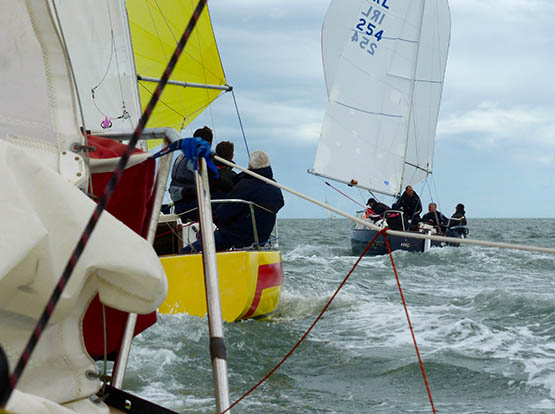
At mid-race, Gold Dust led narrowly from Yellow Peril, but by the start of the last beat, Trick or Treat was leading from Gold Dust with Yellow Peril third. Photo: W M Nixon
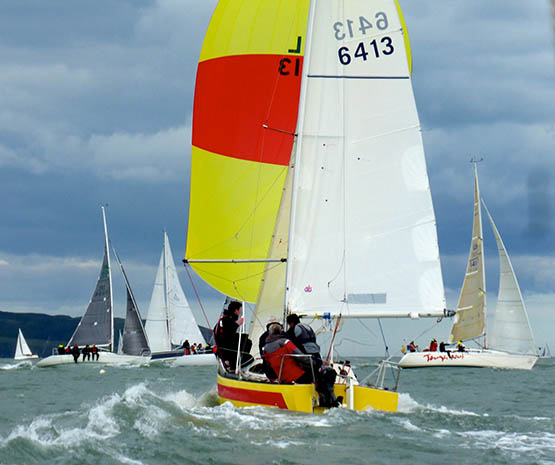
In the MSL Park Motors Autumn League, the mix of classes can sometimes make for interesting situations. Having out-gybed Gold Dust, Yellow Peril is ploughing towards some biggies on another course altogether, and meanwhile there’s the inevitable lobster pot lurking on the way with just one tiny white marker buoy. Photo: W M Nixon
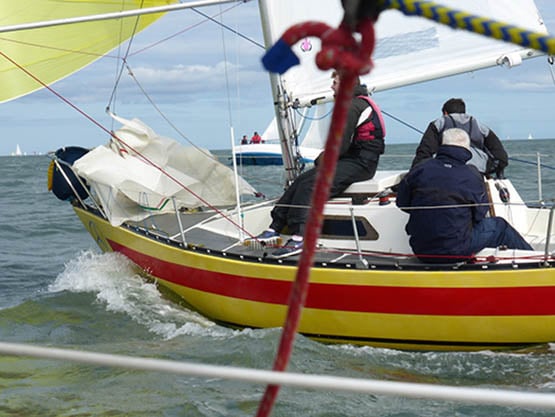
Algy Pearson’s Trick or Treat giving Yellow Peril a hard time to snatch the lead, which she then increased with a cleverly-read long beat. Photo: W M Nixon
But the pace in the Puppeteers is ferocious, and though we’d got a bit of a gap between Trick and former IDRA 14 empress Scorie Walls in Gold Dust, one sneeze from us and Gold Dust would pounce, and alas - we sneezed.
As long as we were carrying the no 2 headsail (what I’d call the working jib) we were level pegging with the formidable Walls-Browne team. But Gold Dust has a lovely new suit of sails (nice ones, Prof), and when the easing wind meant we’d to change up to the genoa, it emerged as a sail of a certain age, and having it set sapped our confidence.
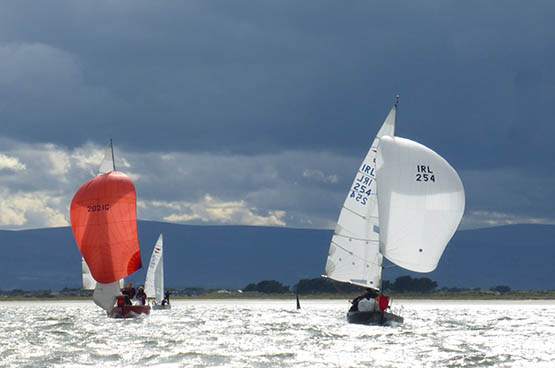
It looked for a while as though Gold Dust (254) had been put fairly comfortably astern……..Photo: W M Nixon
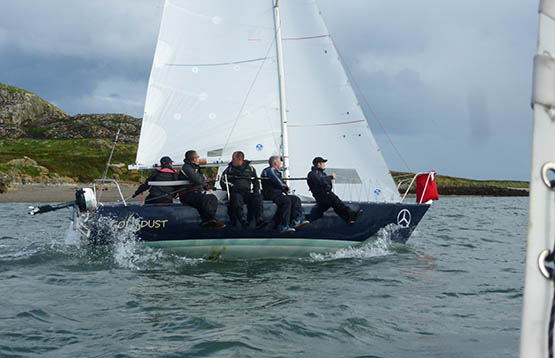
……but an easing of the wind saw Gold Dust finding new speed, and with perfect tactics she was right there with just a hundred metres to go to the finish. Photo: W M Nixon
Until then, the boat had been sailed magnificently, tactics right, trim right, and throwing gybes with such style that the downwind pace never missed a beat. But trying to get that genoa right was a mild distraction, so when Scorie the Queen of the Nile came round the final mark to chase us up the last beat to weather Ireland’s Eye, we’d failed to throw a precautionary tack to keep a loose cover, and suddenly as she rounded she found a local favourable but brief shift of 15 to 20 degrees, and then it was all to play for.
Dissecting it all afterwards (you’ll gather it was a post mortem), we could see two places where we might have still saved the day, but we didn’t grab them, or maybe in truth they were beyond our reach. Whatever, Gold Dust was in the groove and we weren’t. Madam beat us by three seconds. But the banter afterwards and the evidence that Puppeteer people – owners and crews alike – move happily among boats to keep turnout numbers up, was ample proof that here was another truly community based class which perfectly meets a strong local need.

That winning feeling…..Gold Dust’s crew relax after taking first by three seconds. Photo: W M Nixon

The Howth experience. Howth YC Commodore Brian Turvey heads back to port after racing the MSL Autumn League with the Howth 17 Isobel which he co-owns with his brother Conor. Photo: W M Nixon
It had been a great day’s sport, and the Puppeteers being of an age and regularly turning out to race together, they run both a scratch and a handicap system, which is a great improver of local classes – after all, where would golf be without handicaps?
It shows how well Gold Dust has been going this year that her rating is such that we beat her on handicap by one minute and 19 seconds, but we in turn, having been second on scratch, were fourth on handicap, where the winner was the O’Reilly/McDyer team with Geppeto.
Forty years after they first appeared, the Puppeteer 22s are giving better sport than ever, but in a very local context rather than on the bigger stage that might have been anticipated. Yet for their current owners, they do the business and then some. For most folk, this is sailing as it should be. And as to this longterm success of classes which continue to thrive whether they come from a local, national or international background, certainly the quality of the boats is important to some extent. But mostly, it’s the people involved, and their realization that you’ll only get as much out of sailing as you put into it.
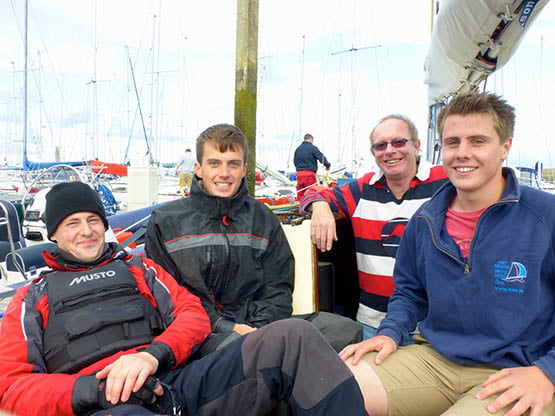
A super crew. Aboard Trick or Treat after racing are (left to right) Alan Blay, Ryan Sinnott, Alan Pearson and Claud Mollard. Photo: W M Nixon

Local man, local boat. Algy Pearson with his Puppeteer 22 Trick or Treat. The Pearsons have been sailng from Howth for three generations. Photo: W M Nixon
How We Won The Flying Fifteen Irish Championships 2015
As Afloat.ie reported on Sunday, David Gorman and Chris Doorly of the National Yacht Club won the 32–boat Mitsubishi Motors Flying Fifteen Championships of Ireland at the weekend beating a visiting triple world champion in the process. Here Chris Doorly describes how the cup was won.
The Notice of Race for National Championships should carry a health warning, both for physical and mental well being! Going up the last beat of Race 6 on Sunday morning we were in sixth place, we needed to be third to win the event and avoid sailing the last race (quiet a luxury really!) The legs were burning, the wind was fickle and the mind was playing games on us, were we going to lose out and leave it all to the last race?
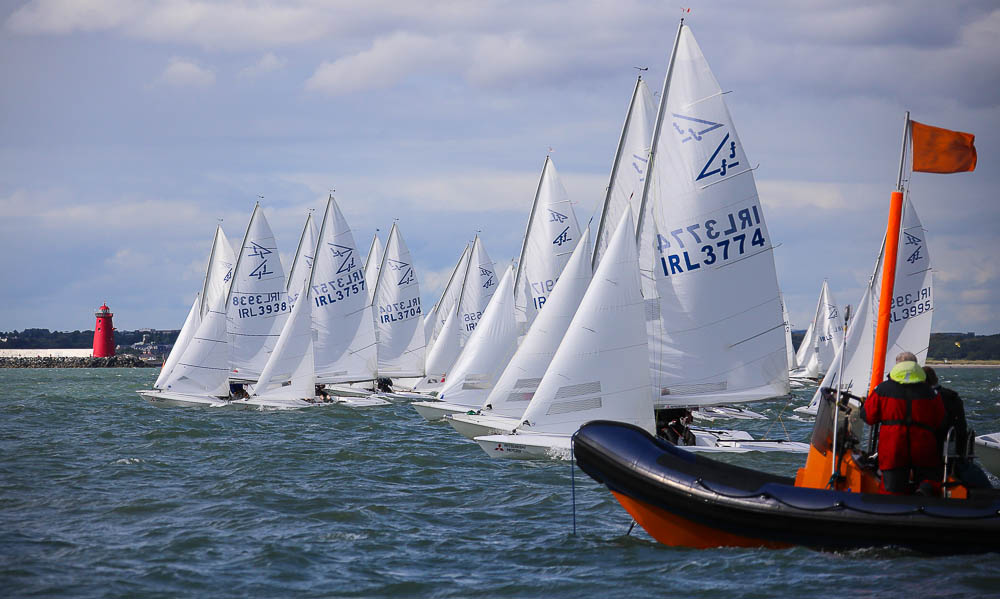
The 32–boat championship fleet start race five
It was not a pleasant thought, patience and calmness were the order of the day, we checked in with our inner mind and settled down to just do what we always do, stick to the process just like the rugby lads! Soon after the leeward gate we got past Brian O’Neill and then Tom Murphy, up to fourth, would it be enough, Dave thought it might be. Last year’s winners Andy and Dougie were in good form today and it was far from a given that we would pass them.
As we approached the weather mark Steve Goacher was leading followed by Sean Craig, we watched the water for pressure it was now light in most places, where would the wind come from next? we saw texture on the water to the right and noticed Steve had a bit more pressure, also at the right as he rounded the mark, we took the risk and went in on port to the right side, on the lay line we tacked and we crossed the lads, third place! Downwind the wind was still light and all over the place, it was a long 1.2 miles to the gate and finish! There was total concentration on the spinnaker. We stayed close to them deliberately, or were they staying close to us waiting to pounce? We just managed to stay ahead gybing at the leeward mark on the inside and crossing the line in third, we had done it! There was great delight on board so much so that some on the committee boat were wondering why we were celebrating after getting third in a race!
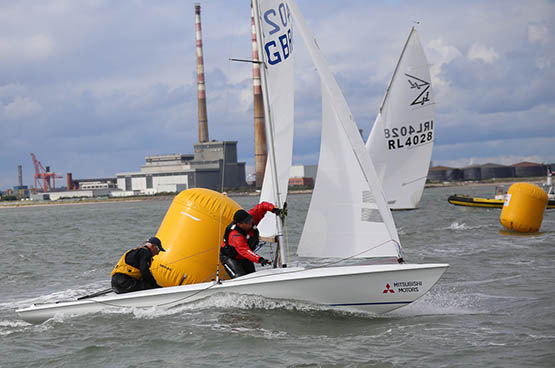
Steve Goacher and Martin Grady prepare for a hoist
It was a three day event with racing starting on Friday, we like the three day events as we tend to go well in all conditions and are not heavy or light weather specialists. In the build up we would have been considered one of the favourites, a tag that means very little in sailing, but with the entry of Steve Goacher and Sean Craig our expectations were dampened but we were determined to give it our best shot.
There was a severe weather forecast for Saturday in particular and it was blowing over 20knots on Friday at the briefing. International race officer Jack Roy and his team put on three races on Friday in case Saturday got cancelled. On the water the 20knots had disappeared and Jack put up the AP. Eventually we got going, there was a general recall on the first start but on the restart the pin was biased and we nailed it, this was critical as the boats at the pin end were the lead boats for the race, Steve led the way at the weather mark and to our surprise we passed him downwind just before the gate, our joy and confidence boost were short lived as the tide pushed us up against the mark and we had to do our turns, we carried on finishing second to Steve with Brian Willis third and Sean Craig fourth, it was good to start with a counter.
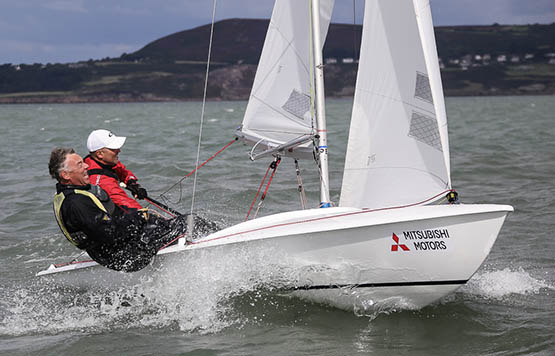
Sean Craig and Alan Green finished third overall
In racing you need a little luck, in race 2 in light conditions we finished second as we were out on what ended up the favoured left side, some would call it the windier side, with Sean Craig who won the race, Steve was on the right and got caught out to finish seventh. Similarly in Race 5 on Saturday in the westerly winds we had spotted wind on the right and got a fantastic 20 degree lift up to the mark as our competitors were on the left side, we went on to win this Race while Sean was fourth and Steve fifth. In saying that we aware that while left into the shore generally pays it was not always the case and our eyes were scanning the course for wind. On Saturday night we had a four point lead but from previous experience we knew that it may not be enough but were delighted to be in the lead and in contention.
Roll on race six on Sunday where we managed the required third place to take the cup back to the National Yacht Club. Race seven was windier with some exhilarating downwind sailing to round of a fantastic weekend of sailing. Again Goacher and Craig didn’t have it all their own way as local boys Ian Mathews & Keith Poole and last years champions Andy McCleery & Colin Dougan took off to be first and second with Steve third, Sean piped us on the line to take fourth place but this was to be our discard.
Thanks to Jack Roy and his race team, the race office, the National Yacht Club and to the local class captain Ronan Beirne along with all the competitors who all did a great job ensuring the success of this event.
Liam Shanahan’s 'Ruth' Retains ISORA Offshore Championship Crown
The last race of the ISORA Avery Crest Offshore series that was sponsored by LC Tyres, took place on Saturday 12th September with the race from Pwllheli to Dun Laoghaire (74 miles) writes ISORA's Peter Ryan. The boats compete for the famous “James Eadie” trophy. As like the same race last season, the weather forecast for the race and particularly the delivery to Pwllheli was not favourable all week. This put off many of taking part in what is normally a well supported end of season race.
The race was of more interest than usual due to the fact that the Overall Championship was still be be raced for with Liam Shanahan’s J109, “Ruth” and Andrew Hall’s J125, “Jackknife” only a 5 point apart and Peter Dunlop and Vicky Cox’s J109 “Mojito” close behind. While either “Ruth” or “Jackknife” could have taken the Series with a good result in the race, “Mojito” needed a well attended race to secure sufficient points in the high points scoring used by ISORA.
Of the 26 entries received for the race, 19 had confirmed taking part on the Monday prior to the race but only 9 came to the start on Saturday morning. Several boats had left Dun Laoghaire the previous morning but turned back when they were met with strong south easterly winds on the nose and a big sloppy sea. Those that persevered were rewarded with nearly “champagne” sailing for the race. Bryan Mullarkey’s Collins 40, “Harriet Marwood” was taking part in an ISORA race for the first time. Richard Mossop’s Oceanis 411, “Yachtzee” and David Simpson’s Swan 371 “Albeiro” were battling for the Overall Class 2.

Liam Shanahan's Ruth from the National Yacht Club has successfully defended her 2015 ISORA offshore crown
Due to the uncertain forecast due to the presence of two depressions, north and south of the race area, the decision was taken to set the course from the start direct in Pwllheli to the finish between the pier heads in Dun Laoghaire.
Despite the poor forecast, the lashing winds during the night and the strong winds, conditions were relative pleasant for the start. The wind was 10-12 knots from the south west giving a beat to the first corner at St Tudwal’s Sound. Stephen Tudor’s J109, “Sgrech” was first off the line and lead the fleet until the faster “Jackknife” too to the front. From the start “Ruth” and Mojito” were always in close contact leaving.
As the fleet approached St Tudwal’s Sound the wind had increased to 20knots and the expected overfalls at the end of the sound awaited the fleet. The next leg was the beat to Bardsay Sound. The wind appeared to veer westerly and maintained the 20-22 knots leaving the fleet to beat through the rough seas towards Bardsey Sound. Fortunately, the tide was right for a fast shoot through Bardsey Sound. Unfortunately, the overfalls in the sound were significant but had settled soon after exiting it.
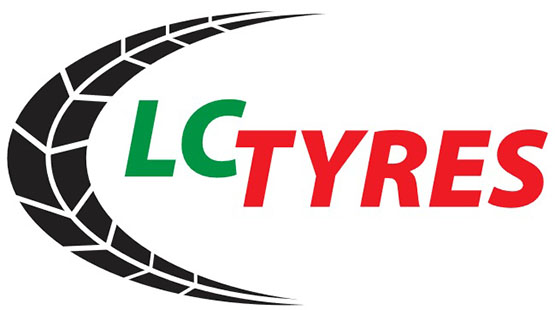
By that stage the battle was on. “Jackknife” cracked sails and took the direct line to Dun Laoghaire in the last of the north going tide. The remainder of the fleet retained their height and the three J109’s with Conor Fogarty’s 2-handed Jenneau 3600, “Bam”, bunched together for the leg to Dun Laoghaire. Shortly after leaving Bardsey the wind backed allowing the boats to ease sails and speed up. Of the bunch of four, “Bam” lead the group with “Ruth” and “Mojito” close behind and “Sgrech” snapping at their heels. Paul Sutton’s “Pipedreamer VI” was just behind this pack.
As the fleet approached the Irish coast the winds abated to 12 knots and backed further to the south allowing those with Code Zeros to accelerate. The positions within the fleet did not change for the long leg despite continuous trimming and hard driving being done on all the boats. It was not until approaching Dublin Bay that “things started to happen”. The winds became fickle and dropped further in Killiney bay. While “Jackknife” avoided much of the light wind to keep powering towards the line, the three J109’s and “Bam” got into a tactical battle with rapid sail changes taking place to deal with the oscillating winds. As the fleet approached Dublin Bay the wind veered to the west and decreased again giving the boats a short final beat to the finish line. Despite the work on each boat the positions generally remained the same.
“Jackknife” took line honours but could only manage 5th Overall allowing “Ruth”, who won the Overall race and Class1 to regain the ISORA Avery Crest Offshore Championship title. Class 2 was won by “Yahtzee” who also won Silver Class.
The crew of Liam Shanahan’s “Ruth” include his four sons. There is a great tradition of offshore racing in the Shanahan family with Liam Shanahan Snr playing a huge part in ISORA racing in the early days.
The race sponsor, LC Tyres, provided day prizes for the race. These were presented at the après sail party that took place in the NYC. The prizes were presented by Caroline Coyne aided by her son, Billy and daughter, Isobel.
The ISORA Avery Crest Offshore Championship trophy, the Wolf’s Head, will be presented to Liam Shanahan at the ISORA dinner in the NYC on the 14th November. “Jackknife” took 2nd place Overall and “Mojito” took 3rd place.
Overall Series Calls 1 was won by “Jackknife” and Class 2 was won by “Albeiro” who also took Overall Silver Class. The team prize, known as the “Victoria Cup”, was again won by Pwllheli Sailing Club.
All the results can be found on the ISORA website. The YB tracking of the race can also be accessed on the ISORA website and on the YB app for smart phones.
Dublin Flying Fifteen Duo Beat Triple World Champion for Irish Title Win on Home Waters
The National Yacht Club's David Gorman and Chris Doorly completed a text book win of the seven race Mitsubishi Motors Flying Fifteen national championships this afternoon, beating in the process the pre–championship favourites, visitors Steve Goacher and Martin Grady from Lake Windemere.
The former triple World Champion finished four points behind Gorman and Doorly who sailed a very consistent series in light and medium winds to count six top three results to finish this afternoon on 12 nett points. Third overall was the Royal St. George Yacht Club's Sean Craig sailing with Alan Green on 16 points, the same score as Goacher who took second place on the tie–break rule.
Full results for the 32–boat fleet are downloadable below.
The fine Irish turnout was only marginally below the 36–boat fleet assembled for this year's British Isles Championships.
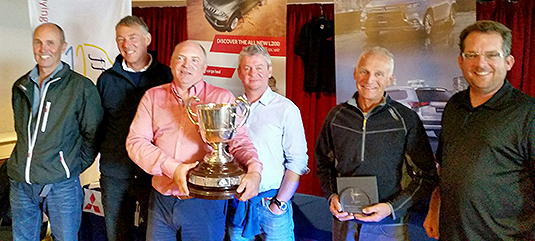
Flying Fifteen podium at the National Yacht Club – From left Sean Craig and Alan Green (third overall), Chris Doorly and David Gorman (winners) and Steve Goacher and Martin Grady (second overall)
Read also: How We Won The Flying Fifteen Irish Championships 2015
World Champion Steve Goacher Joins the Flying Fifteen Fray on Dublin Bay
Triple world Flying Fifteen champion Steve Goacher will sail in this afternoon's Irish national championships sponsored by Mitsubishi Motors. The Lake Windermere sailor is one of a number of visitors for the bumper championships that has attracted a fleet of 32–boats from eight different sailing centres to the National Yacht Club.
More on the event in this morning's Irish Times Sailing Column here.
The first race of the seven race series is on Dublin Bay this afternoon at 2pm but the big question this morning is how strong will forecasted weekend winds blow?
Be careful out there, some horrible weather is on the way http://t.co/4nzr6otADd Pic: @darkskyapp pic.twitter.com/51qTSWxikI
— TheJournal.ie (@thejournal_ie) September 10, 2015Flying Fifteens Launch Irish Championships at National Yacht Club
The Dun Laoghaire Flying Fifteen fleet launched next week's Mitsubishi Motors Ireland 2015 Flying Fifteen Championships of Ireland at the National Yacht Club yesterday.
The Championships will be held next week-end 11 – 13 September on Dublin Bay. There will be seven races for gold, silver and bronze fleets are scheduled over the three days under International Race Officer Jack Roy.
Over 30 boats are expected to compete with visitors from Strangford, Whiterock, Killyleagh, Portaferry, East Antrim, Dunmore East as well as some UK visitors expected.
UK visitor Charles Apthorp sailing with Alan Green will be favourites after their fifth placing at the recent World Championships in France. Current National champions Andrew McCleery & Colin Dougan from Killyleagh as well as former champions Dave Gorman & Chris Doorly from the host club will be hoping to give them a run for their money.
The local Dun Laoghaire FF Committee under the command of Class Captain Ronan Beirne along with NYC Officers/Sailing Manager have been organising the event with one of the ‘off the water’ highlights being a visit to the Maritime Museum.
#dlregatta – As well as winning the 'Volvo Boat of the week award' with George Sisk's offshore performance in Wow, the Royal Irish Yacht Club topped the leaderboard of Dun Laoghaire's waterfront clubs with eight wins across IRC and one designs at yesterday's Volvo Dun Laoghaire Regatta. The club took wins in IRC One, IRC Four, J109, White Sails Two, Dragon, Beneteau 21 and Mermaid. Significantly, the RIYC won two of three national Championships being sailed as part of the extensive 29 class regatta programme. ICRA divison one champion, John Maybury's Joker II came from behind yesterday afternoon to win the J109 Irish title after a battle with Howth Yacht Storm in an 11-boat fleet. Séamus Storan's Capilano of the RIYC overhauled a Scottish entry to win in a 13-boat Beneteau 21 fleet.
As well as boat of the week, the Royal Irish also won VDLR's 'Best Overall IRC Yacht' with an impressive performance by club–quarter tonner Cri–Cri skippered by Paul Colton in IRC four. Paul O'Higgin's Rockabill V took the final advantage yesterday to take IRC one from overnight leader Tony Fox's A35 Gringo of the National Yacht Club who suffered from a premature start.
Neighbours at the Royal St. George YC were not far behind in the winning stakes. The George won in seven classes of the one design divisions from Beneteau 31.7 keelboats to GP14 dinghies. The National Yacht Club had five class victories; White Sails one, Flying Fifteen, SB20, Shipman and Moth.
The event that is organised by all four Dun Laoghaire waterfront clubs is being hailed a huge success both afloat and ashore. Although 180 visiting boats, made up nearly half the fleet, yachts from outside the bay area took away only seven trophies. The bulk of the silverware – 17 titles – have stayed on Dun Laoghaire's waterfront.
{youtube}uZ4s5SUf1nE{/youtube}
#dlregatta – With the Kinsale ICRA Nats/Sovereigns Trophy 2015 very successfully concluded last weekend, and a classic Dun Laoghaire to Dingle Race put stylishly in place before that, the feeling of another sailing summer busily in progress is all-pervasive. But while the image projected may well be one of stately progress by the cruiser-racer fleets along the Irish coast, taking in an offshore race here and a regatta there with much leisurely cruising in between, the reality is usually otherwise. For those boats doing significant segments of the programme, it's a case of fitting chosen events into the usual hectic early summer life of work and family commitments and exams and everything else, with the re-location of boats to the next venue being a hurried task undertaken by delivery crews.
Next week sees the mid-season peak of the sailing summer, with the four day Volvo Dun Laoghaire Regatta 2015 in Dublin Bay from Thursday July 9th to Sunday July 12th. In a way it is an amalgamation of all that has has already occurred in this year's season, together with new elements to make it a unique sailfest which celebrates the fact that the citizens of Ireland's capital city and their guests can be conveniently sailing and racing within a very short distance of the heart of town. W M Nixon sets the scene
In the dozen or so years since its inception, the biennial Volvo Dun Laoghaire Regatta has settled itself firmly into the sailing scene as an exceptionally varied event in terms of the boats and classes taking part. There are five regular cruiser-racer classes, plus an offshore division, fourteen one design keelboat classes, and nine dinghy classes. And although there are contenders from Ireland's north coast and from the Cork area and south coast too, together with one gallant entry from Galway, it is essentially an Irish Sea Sailfest, though with a remarkably strong Scottish presence.
However, it was on the coast of Wales at 8.0pm last night that this sailing celebration began, with an ISORA Race starting in Holyhead and heading for Dun Laoghaire to set this large and complex programme into action towards a culmination on Dublin Bay in eight days time with the conclusion of VDLR2015.
2015 marks the Bicentennial of the Royal Dee YC, which was founded in 1815 on the Cheshire shores of the River Dee estuary where northwest England marches with northeast Wales. Originally the Dee Yacht Club (and founded, it's said, a month or two before the Royal Yacht Squadron came into being in the south of England, making the RDYC the second-oldest Royal yacht club in England after the Royal Thames), the Cheshire club became the Royal Dee YC in 1847.
Although the great prosperity of Liverpool in the 19th century saw the club's fleet of substantial yachts gathered in the Dee and then increasingly in the Mersey, by the late 1900s it was looking to the Menai Straits area as the focus of its keelboat events. As well, the completion of Holyhead breakwater in 1873 added a new and important harbour to its list of possible big boat sailing locations, and there was an increase in the number of cross-channel "matches" which the Royal Dee and the Royal Mersey, in conjunction with the Dublin Bay clubs, had already been running for some years.

A Royal Alfred YC cross-channel match from Dublin Bay to Holyhead gets under way in 1888. Cross-channel links were strong in the latter half of the 19th Century, and with the new breakwater completed at Holyhead in 1873, a new venue was available both for the Irish clubs and those on the other side such as the Royal Dee and the Royal Mersey

The bicentenary logo of the Royal Dee YC. In 1815, this club on the Cheshire coast was founded shortly before the Royal Yacht Squadron in the souh of England, whose Bicentennial is being celebrated at the end of July.

Dun Laoghaire saw its first regatta staged in 1828, and participation by yachts from the northwest of England and North Wales was regularly recorded. This is the Royal St George YC regatta of 1871.
So when we say that the Royal Dee has always been a stalwart of offshore racing in the Irish Sea, we're not referring to a story spanning only the 20th and 21st Centuries. On the contrary, it goes well back into the 1800s. And now, with the revival of keelboat sailing in the Mersey with several of Liverpool's myriad docks being given over to recreational use, we have in a sense come full circle with enthusiastic Dublin Bay support of the Bicentennial celebrations reflecting sailing links which go back almost 200 years
The Lyver Trophy is the Royal Dee's premier offshore challenge, and this year it is special, as it's a fully-accredited RORC event counting for points in the annual championship, and a highlight of the ISORA Programme 2015. It's start scheduled for yesterday evening in Holyhead will see the fleet – mostly regular ISORA contenders – sail a course of at least a hundred miles before finishing in Dun Laoghaire. Then as VDLR 2015 gets under way, races in it, combined with the Lyver Trophy results, will count as part of a series towards finding an overall winner of the RDYC Bicentennial Trophy.
Only entrants in the Lyver Trophy race are eligible, and for that race itself – which can be followed on the Averycrest Yellowbrick Tracker - the favourite has to be the Shanahan family's J/109 Ruth, still buoyed up by her great victory in the Dun Laoghaire to Dingle Race three weeks ago.

Back in The Bay – the Shanahan family's J/109 Ruth will be back in her home waters of Dublin Bay after winning the Dun Laoghaire to Dingle Race and completing the Lyver Trophy Race from Holyhead which started last night. Photo: David O'Brien
At the other end of the size scale, the VDLR2015 Dublin Bay programme includes several dinghy classes, and the biggest fleet will be mustered by the International GP 14s, who have designated the racing in Dublin Bay as their Leinster Championship. In an interview with Sailing on Saturday in March, VDLR Chairman Tim Goodbody emphasised that, overall, the event should be seen as a regatta rather than a championship, and for most boats that's just what it will be. But the GP 14s with their great esprit de corps have always done things their own way, and with their compact boat size – albeit comprising a large fleet of dinghies – they reckon they can get in a proper championship while sharing in the fun of the event.
 The brothers John and Donal McGuinness of Moville Sailing Club in Donegal are expected to be among the pace-setters in the GP 14 class with their superb Alistair Duffin-built boat. Photo: W M Nixon
The brothers John and Donal McGuinness of Moville Sailing Club in Donegal are expected to be among the pace-setters in the GP 14 class with their superb Alistair Duffin-built boat. Photo: W M Nixon

The GP 14 Ulsters 2015 were recently won on Lough Erne by Shane MacCarthy & Damian Bracken of Greystones
As to who is favourite, the McGuinness brothers – Donal and John - from Moville in Donegal, with their top-of-the-line Duffin boat built in Northern Ireland, have to be in the reckoning after being top Irish at last year's Worlds on Strangford Lough, but there's fresh blood in the fleet with the newest class developing at Youghal, while this year's recent Ulster Championship on Lough Erne was won by the Greystones duo of Shane MacCarthy and Damian Bracken.
The dozen and more boats coming south from Scotland, most of them substantial cruiser-racers, are testimony to a growing trend in sailing on Europe's Atlantic seaboard. Given a choice of venues, your average yachtie on this long coastline will incline to head south if at all possible. Other things being equal, it's reckoned the further south you go the warmer it is likely to be. And from the upper reaches of the Firth of Clyde, there are times when Dublin Bay might seem like the distant and sunny Mediterranean.
Maybe so, but we'd caution that much depends on the moods and location of that all-powerful weather determinant, the northern Polar Jetstream. In July, so long as it's well clear of Ireland -whether to the north or the south - we will have glorious high summer, and that occurred for the previous VDLR back in 2013, where the photos speak for themselves.
So we hope for the best in looking forward to welcoming a fleet of around 415 boats to Dun Laoghaire between July 9th and 12th, with all four of our in-harbour yacht clubs extending the hand of hospitality in a regatta tradition that goes right back to 1828. But while heritage and ceremonial are all very well in their place, it's the prospect of good sport which energises the participants and their sailing, and with several major contests already logged in 2015, what can we expect on the leaderboards next week?
At the top of the tree, Class 0 has formidable competition, including former Scottish champion Jonathan Anderson racing his XP38i Roxstar against the Royal Cork's Conor Phelan with the Ker 37 Jump Juice, which was one of the best performers in last year's ICRA Nationals at the same venue, and this year again became a force to be reckoned with as the breeze sharpened in the four day Kinsale ICRA Nats 2015/Sovereigns Cup a week ago.
 Freshly squeezed – her storming finish to last weekend's final race of the ICRA Nats/Sovereigns Cup at Kinsale makes Conor Phelan's Ker 37 Jump Juice one of the top contenders in the VDLR2015. Photo: David O'Brien
Freshly squeezed – her storming finish to last weekend's final race of the ICRA Nats/Sovereigns Cup at Kinsale makes Conor Phelan's Ker 37 Jump Juice one of the top contenders in the VDLR2015. Photo: David O'Brien
With a win in the final race, Jump Juice came in second to seasoned campaigner George Sisk's class overall winning Farr 42 WOW (RIYC), the pair of them in turn displacing the early leader, lightweight flyer Mills 36 Crazy Horse (ICRA Commodore Nobby Reilly & Alan Chambers, HYC) down to third in the final day's racing, so Crazy Horse will be hoping for a return of lighter breezes when racing starts next Thursday on Dublin Bay.
In the previous Volvo Dun Laoghaire Regatta in 2013, the most successful boat in was Nigel Biggs' much-modified Humphreys Half Tonner Checkmate XV, but this year the Biggs team is racing as Checkmate Sailing with the newest boat in the fleet, the Mark Mills-designed American-built C & C 30 OD Checkmate XVI. She may be only 30ft LOA, but she's such a hot piece of work with so many go-fast bells and whistles that she has a rating of 1.140 to put her in Class 0.
The oldest boat in the cruiser-racer fleets will be found in Class 3, where the 44ft Huff of Arklow is making an historic return to Dublin Bay racing. Originally built in 1951 by Jack Tyrrell of Arklow to a design by dinghy genius Uffa Fox, Huff is so-called because her concept is reckoned three-quarters Uffa Fox and one quarter Douglas Heard. The latter was the founding President of the Irish Dinghy Racing Association in 1946, and he later went onto to become Commodore of the Royal St George YC and a noted cruising and offshore racing enthusiast with this unusual boat, which is like a very enlarged Fying Fifteen with a lid – in fact, with her 30ft-plus waterline, she was described as a Flying Thirty. In recent years she has undergone a total restoration with Cremyll Keelboats near Plymouth in Devon, and Dominic Bridgeman of the Cremyll group will be racing her with trainee crews in her old home waters of Dublin Bay.

The Flying Thirty Huff of Arklow racing off Dublin Bay while under Douglas Heard's ownership in the 1950s. Built by Tyrrell's of Arklow in 1951, the hugely innovative Huff has recently had a major restoration, and will be making her return to Dublin Bay to take part in VDLR2015.
Among the newer boats on the bay, the 2013 champion Checkmate XV is still very much in the picture, but now she's owned by Howth's Dave Cullen, and took second overall in class in the Kinsale series a week ago. In Dun Laoghaire next week, she's with other Half Tonners at the lower end of the Class 2 rating band on 0.944, almost 200 rating points below the new Biggs boat. Class 2 also includes the Division 3 winner at Kinsale, Richard Colwell & Ronan Cobbe's Corby 25 Fusion (HYC) which bested VDLR 205 Chairman's Sigma 33 White Mischief in a real duel after they went into the final day's racing equal on points, while another Kinsale success story in the Class 2 lineup is Paddy Kyne's X302 Maximus from Howth, overall winner of the Portcullis Trophy for top ECHO boat.

Dave Cullen's modified Half Tonner Checkmate XV will be looking to take the top slot on Dublin Bay after being runner-up in Kinsale. Photo: David O'Brien
In between the two Checkmates on ratings, we find most of the cruiser-racer fleet, with Class 1 shaping up some interesting competition between the likes of Paul O'Higgins Corby 33 Rockabill (RIYC), Kenneth Rumball skippering the Irish National Sailing School's Reflex 38 Lynx, and two very sharp First 35s, Prima Luce (Burke, Lemass & Flynn, NYC & RIYC) and another former Scottish Series champion, John Corson (Clyde Cr C) with Salamander XXI.
This year's Scottish Series Champion and the Afloat.ie "Sailor of the Month" for May, Rob McConnell of Dunmore East, will certainly be racing in the VDLR 2015, but whether or not it's with his all-conquering A35 Fool's Gold (second in class at Kinsale) or aboard another boat (a Flying Fifteen) remains to be seen. And the Top Sailor Count doesn't end there, as there'll be at least four Olympic sailors involved in four different classes, with Robin Hennessy racing in what has all the marks of a quality International Dragon fleet against the likes of former Edinburgh Cup winner Martin Byrne, Annalise Murphy racing in the Moths which will surely be a change from the Water Wag which she raced with her mother Cathy MacAleavy (also another ex-Olympian) last time round, and Mark Mansfield helming John Maybury's J/109 Joker 2. After Joker 2's class overall win in Kinsale, we can expect a battle royal in the J/109s with boats of the calibre of Ruth for the National title fight.

The Shipman 28s find that the sport and socializing which the VDLR guarantees will provide some of their best racing of the year. Photo: VDLR
The J/109s are the queens of an impressive array of One Design keelboats which includes Sigma 33s (where VDLR 2015 Chairman Tim Goodbody's White Mischief is racing under the command of Paul McCarthy), Beneteau First 31.7s, Shipman 28s having one of their best gatherings of the year, Ruffian 23s with a good turnout, the attractive First 21s which are steadily gaining traction as a Dublin Bay class, and best OD keelboat turnout of all is by the Flying Fifteens, nearly all of them under the NYC flag.

Olympians all – in VDLR2013, Olympic sailors Cathy MacAleavey (1988) and her daughter Annalise Murphy (2012) raced the family Water Wag Mollie. But while Cathy will be sailing Mollie again this year, Annalise will be on her own racing a foiling International Moth.

Newest of the oldest – Adam Winkelmann and Doug Smith's new French built Water Wag No.46, Madameoiselle, has been launched in time for the regatta. Photo: Owen McNally

The Howth 17s of 1898 vintage will be the oldest class racing. Photo: David Branigan
Veteran classes include the IDRA 14s from 1946, the Glens from 1945, the Howth 17s of 1898 which pre-date the 1902 Water Wags, and the 1932 Mermaids, the latter being in the interesting position of no longer having an official division in Dun Laoghaire, yet it's a Dun Laoghaire skipper, Jonathan O'Rourke of the National, who continues to dominate the class both at home and away.
With large fleet numbers afloat guaranteed, the shoreside programme is appropriately busy, with the official side of each day's racing concluded by the evening's daily prize-giving at one of the four waterfront clubs. But with so many sailors involved, there'll be action in all the clubs – and at other establishments in Dun Laoghaire - throughout the week. The scene is set, let the party begin at a venue which has been staging regattas since 1828.
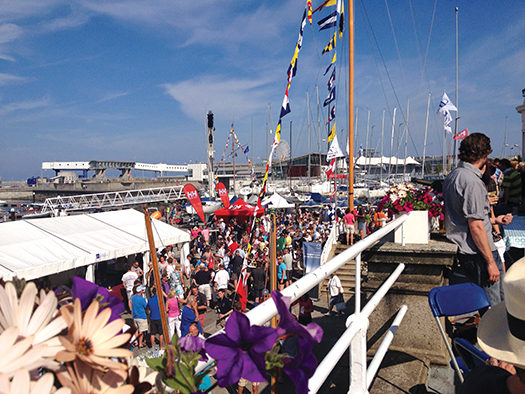
When the summer comes, the après sailing at the VDLR is world class. Photo: VDLR
Further reading:
Download the full entry list for Dun Laoghaire Regatta 2015 class by class below
Download the Sailing Instrcutions for Dun Laoghaire Regatta 2015 HERE
- Dun Laoghaire Regatta
- Volvo Dun Laoghaire Regatta
- Royal St George Yacht Club
- Royal Irish Yacht Club
- National Yacht Club
- ISORA
- Water Wags
- Royal Alfred Yacht Club
- yellowbrick
- GP 14
- Nigel Biggs
- George Sisk
- Annalise Murphy
- Half Tonners
- Tim Goodbody
- Mermaid
- Fool's Gold
- Dragon
- Irish National Sailing School
- Kenneth Rumball
- Dublin Bay
#sailability – On the 26th June four sailing cruisers from Lough Foyle will set off from Greencastle in Donegal on a round trip passage of Ireland stopping at each Sailability Club around the coastline of Ireland. This is to promote Sailability - sailing for disabled people in Ireland. Sailability Ireland is the new name for the Irish Disabled Sailing Association (IDSA) which was established in 1980 to introduce and encourage people of all ages with disabilities to take up sailing. Thirty years later, Sailability Ireland members are involved in all levels of the sport, from regular club racing, through international championship, to Paralympic Campaigns.
The cruisers will arrive in Dun Laoghaire for the day on Monday 29th June where they will be hosted by the Royal St George Yacht Club and Dun Laoghaire Sailability. D/L Sailability run a very successful programme of courses for disabled children throughout the Summer. 35-40 children are involved in the sailing thanks to the support of the four waterfront clubs, the Royal St. George, the National, the Royal Irish and the DMYC, as well as their instructors and volunteers.
To mark the occasion Sailability sailors from Dun Laoghaire will meet the Lough Foyle Crews for a BBQ at the Royal St. George and then head off in local cruisers at 6pm and accompany the Lough Foyle as far as Dalkey Island or perhaps Killiney Bay as they head towards the next port of call Kinsale.
Sailing for disabled people in Ireland has blossomed over the last few years and there are now centres in all provinces in Ireland. In Dun Laoghaire the programme started 6 years ago and has grown every year to the extent that all of the events this season are full, from the regular Sunday morning sailing to the week courses in June and August .
This year the Royal Irish are hosting the Presidents Cup an all-Ireland competition for disabled sailors with a team from each Province competing in 4 different types of boats. the event will be held in Dun Laoghaire harbour on 22nd and 23rd August
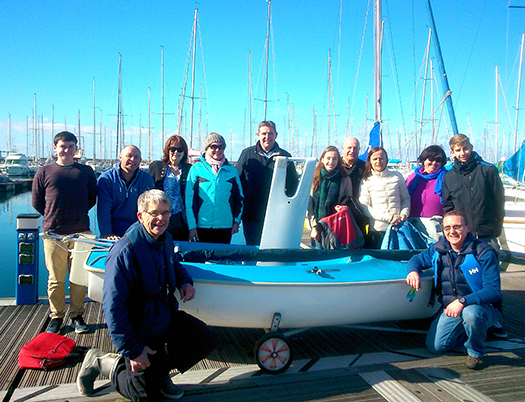
Royal St. George Yacht Club 'Phantom' Sailors Rule at Dragon National Champs on Dublin Bay
#dragonnationals – Neil Hegarty at the helm of Phantom who led the 2015 Dragon National Championships from start to finish was presented with the winners trophy at the National Yacht Club this afternoon. The Royal St. George YC crew of Hegarty, David Williams and Peter Bowring who took an early lead on Friday afternoon were challenged first by Salcombe entry, Bear, skippered by Martin Payne.
Another challenge in the 13–boat fleet emerged yesterday from Kinsale's Little Fella (Cameron Good) but in the end no one could match Phantom's blistering pace downwind that gave the Royal St. George crew a 100–metre lead in today's final race seven.
By adding two race wins to the final scoresheet tally, Hegarty, Williams and Bowring took the title by a margin of five points from Payne. Last year the Phantom crew finished second to Lawrie Smith in a 21–boat fleet in Kinsale.
Royal St. George club mate Andrew Craig sailing Chimaera was one point further back in third overall. Racing was run under the NYC's Race Officer Con Murphy and his team.
Full results downloadable below.

Final race photos by Cathy MacAleavey
